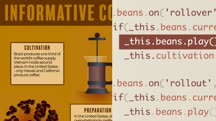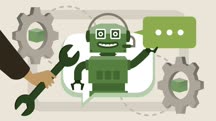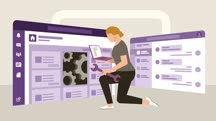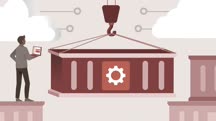Course catalog
Categories
Showing 421-440 of 1,450 items.
Designing Interactive Infographics with Adobe Animate (223411)
Learn how to use Adobe Animate to design a fully interactive, animated infographic for use on the native web. This course explores document and layer management, instantiation of infographic assets, and the creation of additional vector shape data and text to create a full infographic layout. Following this, instructor Joseph Labrecque shows how to add motion to various portions of internal symbol timelines to augment user interactions like hovers, clicks, detail reveals, and more. Finally, he reviews how to add interactive elements to the infographic—tying together the layout, internal motion, and info detail reveals into a smooth package to be published for use on the native web.
Developer Career Paths and Certifications (217019)
Technology has changed the way we approach ordinary tasks—from settling the bill at restaurants to driving—and more industries than ever are leveraging tech to work smarter. It's a great time to launch a career as a developer in this ever-changing field. But with so many options to choose from, how do you determine which path is right for you? In this course, senior staff instructor Ray Villalobos shares best practices and tips designed to help aspiring developers find the right path and build their careers. Ray explores the market, job titles, and responsibilities for different types of developers, as well as how much you can expect to make. He covers what subjects you need to master and how you should approach your education. Plus, he steps through the job search process, explaining how to fine-tune your resume, tackle phone interviews and coding challenges, negotiate compensation, and even prepare for your new job once you land it.
Developing a Critical Thinking Mindset (214894)
Critical thinking is often cited as a desirable skill to have, but what exactly does it mean to be a critical thinker, and how does one achieve this mindset? The goal of critical thinking is to give ourselves time and tools for improving how we think, to see things closer to how they really are, and get a better sense of the world. But just understanding the concepts won’t get you there. As Becki Saltzman explains, developing a critical thinking mindset requires commitment and deliberate practice. Becki shows how to put critical thinking knowledge to work to create a mindset that enables you to examine information and determine how to assess information you can trust. She also shows how to develop mental agility to apply insights from one context to the next, ways you can avoid overthinking, and tips on how to balance rational, strategic, and even emotional thinking. After this course, you’ll be on your way to developing the mindset necessary for critical thinking to flourish.
Developing Business Partnerships (230704)
Over the course of your career, you work with many different stakeholders in many different facets. A business partnership can be one of the trickier relationships to navigate. In this course, longtime business executive Marcel Badart discusses the skills you need to identify, develop, and build strategic business partnerships and sustain them over time. Marcel walks you through factors that influence a partnership, from the nature of the relationship to the stakeholders involved. He explains the steps in developing the relationship, including prospecting, negotiating, and onboarding your new business partner. He concludes with pro tips on how you can ensure a successful, long-term partnership.
This course was created by Madecraft. We are pleased to host this training in our library.

This course was created by Madecraft. We are pleased to host this training in our library.

Developing Chatbots with Azure (230483)
What exactly is a chatbot? How does it differ from a bot, how can you develop one, and how can you use it, once it is developed? Instructor Bhavani Ravi walks you through learning about chatbots and developing your first one. Bhavani begins by describing what a chatbot is, what types of chatbots exist today, and how a chatbot differs from bots and applications. She goes over the components of a chatbot system and discusses the natural language processing (NLP) that allows chatbots to understand requests in human language. She steps through designing a chatbot, then shows you the “brain” of a chatbot: ML models. Bhavani shows you how to use ML models to train your chatbot, challenges you to write your own chatbot, then concludes with some projects that you can work on and submit to GitHub.
Developing for Microsoft Teams (219892)
Microsoft Teams is one of the fastest growing enterprise tools and lets workers collaborate, conduct meetings, share data and information, and use applications, all within Teams. The versatility of Teams means it is also a rich development platform. In this course, software developer Bill Ayers teaches how to build custom tabs and extensions in Teams using open web technologies like Node.js, TypeScript, and React. With more and more users not just using Teams, but also doing more and more within Teams, understanding how to develop for this platform will be increasingly important for any software developer who wants to reach their users where they are.
Developing for Web Performance (211103)
Performance matters! Faster websites have been shown to increase visitor retention, loyalty, and satisfaction, especially on mobile. In this course, discover how to develop websites and applications with performance in mind. Since the cause of most slowdowns is the communication between the browser and the server—the realm of HTTP—senior staff instructor Morten Rand-Hendriksen goes over the HTTP/2 protocol, which offers web developers huge performance enhancements. Morten then covers how to keep your team focused on performance by creating a realistic performance budget. He explains how to optimize images (one of the biggest resource hogs), code, and file caching, as well as server delivery and browser handling. Plus, learn how to optimize CSS and JavaScript and use a content delivery network to speed up download times. Upon wrapping up this course, you'll have the basic knowledge you need to develop websites and apps that thrive in the age of the lightning-fast web.
Developing Visual Campaigns (112979)
Today's audiences crave custom, quality visual content delivered with intent—but they don't respond to one-off content pieces the way they used to. Gone are the days when a single infographic could garner thousands of views and backlinks. Today, audience expectations have grown and with that, successful brand marketers are combining 12–14 types of visual content into single campaigns to meet those expectations. This means that the growing demand for skilled designers will continue long into the future. To remain relevant, designers will be expected to both art direct and execute on these campaigns, stretching their skillsets across dozens of visual content mediums.
In this course, Amy Balliett—CEO of the visual communications agency, Killer Infographics—provides an in-depth look behind the curtain of visual campaigns. She shares her experiences and the lessons she learned from developing over 100 visual campaigns for Fortune 1000 clients and nonprofits, explaining how to develop a successful campaign from start to finish. She walks through how to concept and plan a campaign, and how to pitch that campaign to clients and colleagues. Amy also takes you through how to develop a visual language to guide your campaign, and shares how to avoid common pitfalls.
In this course, Amy Balliett—CEO of the visual communications agency, Killer Infographics—provides an in-depth look behind the curtain of visual campaigns. She shares her experiences and the lessons she learned from developing over 100 visual campaigns for Fortune 1000 clients and nonprofits, explaining how to develop a successful campaign from start to finish. She walks through how to concept and plan a campaign, and how to pitch that campaign to clients and colleagues. Amy also takes you through how to develop a visual language to guide your campaign, and shares how to avoid common pitfalls.
Developing Your Creativity as a Leader (232047)
Creativity is the top skill that companies seek in their employees, but as leaders, how many of us optimize our own creative skill-building? In this course, instructor Denise Jacobs identifies how to shift into a creativity mindset, ignite and up-level your own creative thinking, and cultivate creative confidence in your teams. Denise begins with ways you can develop a creativity-thinking mindset, prevail over perfectionism, and lay a foundation to amplify creative thinking. She steps you through techniques to ignite your creative spark and up-level your creative problem-solving. Denise concludes by teaching you ways you can build creative confidence in yourself and your teams. By building your creativity-thinking skills, you can become a connected and trusted role model, able to spark change that transforms workplaces for the better.
DevOps for Databases in Azure with MySQL and Terraform (232608)
If you’re already familiar with DevOps practices and are wondering if these methods can apply to databases as well, this is the course for you. In this project-focused course from CloudSkills, instructor Michael Levan reveals how DevOps for databases is not all that different from what you might already be doing. Michael starts off with some basics of DevOps for databases, like why it’s important, and the tools you use in DevOps today that can be used with databases. He then gets into the project, showing how to create a MySQL database with Terraform, and how to take that same Terraform configuration and automate, via CI/CD, the MySQL dataset creation with Azure DevOps. If you’ve been wondering why you might want to use DevOps for databases, this course provides some answers—you no longer have to hold up app delivery; collaboration between teams means better deployment outcomes, procedures, and automation—along with a project you can work on that illustrates these benefits.
Note: This course was created by CloudSkills.io. We are pleased to host this training in our library.
Note: This course was created by CloudSkills.io. We are pleased to host this training in our library.
DevOps Foundations: Containers (219025)
Containers are an amazingly versatile and powerful tool in the DevOps toolkit that can remove or smooth over a lot of the usual pain points in application development. Instructor Josh Samuelson goes over what containers are, where and when you can use them, and how to manage them well. Josh begins with a thorough explanation of what containers are, why you should use them, and how containers differ from VMs. He covers using containers in development, packaging, and production, with examples and factors to consider for each. Josh concludes with an in-depth look at how you can use Docker Swarm, Kubernetes, Mesos, and cloud container solutions to manage your containers effectively.
DevOps Foundations: Containers (2017) (227219)
Software containers are the future of app deployment—and an instrumental component of any DevOps strategy. They package everything a program needs to run, allowing developers to move applications from one environment to another relatively hassle free. In this course, cloud-computing luminary David Linthicum dives into the exciting world of software containers. David goes over the basics of containers, including an overview of the fundamental steps involved in building container-based software, followed by some examples of real-world applications that leverage containers. The course concludes with container standards and best practices, and the tools, processes, and skills a DevOps professional needs to work with them.
DevOps with AWS (234699)
DevOps describes a culture and set of processes that bring development and operations teams together to simplify software development. It allows organizations to create and improve products at a faster pace than they can deliver with traditional software development approaches. And it’s gaining in popularity at a rapid rate. In this course, programmer Dipali Kulshrestha covers the concepts of DevOps with hands-on demos to create and automate CI/CD (continuous implementation and continuous delivery) pipelines. She covers AWS services like CodeCommit, CodeBuild, CodeDeploy, and CodePipeline, and how to implement DevOps with AWS offerings to increase security, scalability, reliability, and simplicity of the development processes.
Digital Accessibility for the Modern Workplace (216475)
The move towards a more digital workplace affects everyone, from newly remote employees to frontline workers. With technology being such a critical part of how we do our jobs, having accessible solutions is essential to providing an inclusive workplace. In this course, join Hector Minto, an accessibility evangelist at Microsoft, as he shares how to use accessibility solutions across your tools and processes. Hector covers the importance of accessibility, as well as how modern trends have brought accessibility to the forefront. He also shares technology solutions for each type of disability and provides best practices for developing more inclusive experiences in your meetings, emails, presentations, and social media posts. After taking this course, you’ll have the tools you need to start creating a work environment that is inclusive.
Note: A version of this course with audio descriptions is available in our library.
Note: A version of this course with audio descriptions is available in our library.
Digital Networking Strategies (173873)
Cultivating a professional network online is a key component of career advancement and landing new job opportunities. In this course, career coach Christopher Taylor covers why networking is valuable and shares ways to connect with decision-makers in any industry. He discusses which tools and platforms are most effective for digital networking, and provides specific steps for reaching out and being successful at connecting. Plus, learn about what it means to create a personal brand, and how to be intentional with personal branding.
Digital Strategy (192335)
Digital disruption is changing every business. Only a decade ago, the auto industry was well-defined by players such as GM, Ford, and Toyota. Today, these companies compete with newcomers such as Uber and Lyft, which sell transportation services—not cars. Similar dynamics are playing out in retail, banking, education, and even construction. This course examines how digitization reshapes the opportunities and threats facing companies—and how you can harness the power of digitization to win. Join Anil Gupta and Haiyan Wang to learn how to develop your own digital strategy. Discover how to harness artificial intelligence, use new platforms to beat the competition, and digitize products, services, and other elements of the value chain: design, development, sourcing, production, and distribution.
Discussing Racism with Dr. Christina Greer (234716)
Dr. Christina Greer, renowned author, educator, and expert on American history, Black ethnics, and public policy, provides an engaging course intended to show that conversations about race and racism can be healthy, productive, and impactful. Christina delves into important topics such as the reasons people may be uncomfortable talking about racism, best practices for speakers and listeners, the real-life impacts of racism, and how conversations can lead to action.
Distributing Your Android App for Kotlin Developers (226454)
So you’ve built an Android app, and you’re ready to share it with the world. Now what? There are many ways you can distribute your app, and in this course, Jon-Luke West shows you how to use the primary distribution channel, the Google Play Store, as well as the Amazon Appstore. Jon-Luke covers how to prepare the app for distribution by cleaning up and optimizing the code, creating a security certificate, and uploading an APK file. He then shows how to create multiple flavors of your app to include different features, how to register as a Google Play and Amazon developer, set the app description and pricing, and publish the app. Lastly, Jon-Luke looks at the post-publishing aspects, including how to track app usage, usage statistics, revenue, and crash reporting.
Ditch Your Git GUI: Customize Terminal (218464)
A lot of the power of Git—especially when you need to untangle something—is hidden in the command-line interface (CLI). While CLI terminal software may seem intimidating, instructor Melanie Panem shows you ways to make your command-line interface environment more friendly and approachable to work in. Melanie explains various Git GUI software options and compares terminal program options. She walks you through the different shell environments and the common tools you might need. Melanie goes over the standard settings and preferences that are probably already available on your terminal, then dives into using and customizing a rudimentary version of your terminal’s shell, Bash. Once you’ve seen what Bash can do for you, she describes newer shells like Zsh and fish, which can be used to make Bash more efficient. Melanie finishes up by showing you the commands you need for CLI and Git.
Diversity and Inclusion in Marketing: Inclusive Language for Marketers (215387)
Words matter. For as much as words can make a positive impact with an audience, they can also divide and alienate us. Now more than ever, it’s critical for marketers to intentionally use inclusive language. In this course, Andrew McCaskill, Senior Director of Global Communications at LinkedIn, shares practical guidance on this critical topic. Andrew outlines the basics of inclusive language, and he provides a framework to evaluate your marketing assets, such as checking for stereotypes and gender-inclusive language. If you’re looking for a guide to help you navigate the critical aspects of diversity and inclusion, join Andrew in this course.



















